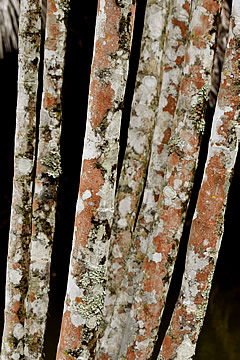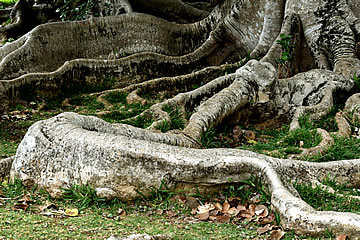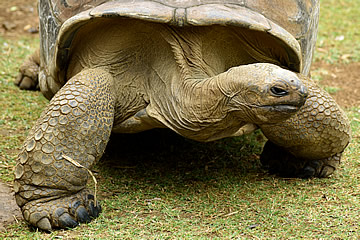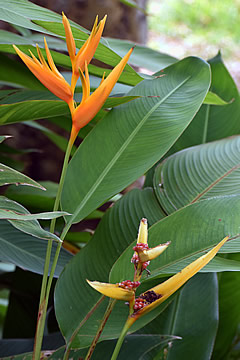


One of our less hectic holidays in a beautiful hotel on the beach. A Mauritian street food tour in Port Louis was the perfect way to delve deeper into local life - not to mention the great food!


Mauritius lies over a thousand kilometres east of Madagascar in the Indian Ocean. It was once the only home of the dodo, a large flightless bird which became popular as a source of meat for ships on the trade routes - it then rapidly became extinct.
A peaceful, multicultural, tropical island with a wide diversity of plant life, we were looking forward to a somewhat less intense holiday than we normally take!

We chose this lovely hotel, Angsana Balaclava, because it was on the west coast, not the very windy east coast, and because it looks beautiful - the decor throughout is local style. It is highly individual in character and right on a very secluded stretch of beautiful white sand beach.

The pool was lovely and, as even here on the west coast the wind can get up, very sheltered, with a handy bar restaurant.


Our room had it's own deep plunge pool high up on the third floor, with superb views over the ocean, though the water was generally far too cold for comfort - a little too early in the season for it to have warmed up perhaps!

The room itself was fabulous, we particularly liked being able to watch the dawn from our bed - and the sunsets weren't too shabby either!

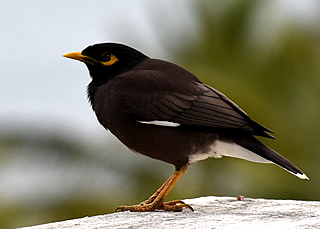


There was quite a variety of bird life around the hotel, including a large colony of yellow village weavers, noisily nest-building.



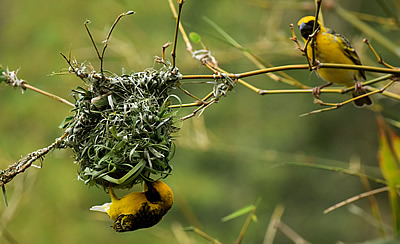

There was a continuous very loud squawking as the weavers built their nests, I can't think it was from the birds actually doing the building as most of the manipulation is done with their beaks!




This was just a week's holiday so we planned a couple of days' reading and relaxing, going out on the hotel's glass-bottomed boat, and a couple of excursions.

The week began with very hot days but gradually cooled. We dined outside on a couple of evenings but on the rest I was glad I'd brought wraps and we sat inside - the restaurant is open-sided so it's not entirely divorced from the gardens. Many guests didn't seem to find it too cool, though, and dined outside the whole week.

The coral reef is very close to shore. When we went out on the glass-bottomed boat we saw quite a variety of colourful fish - stripey, bright blues and yellows, plus lots of anemones and clams and different types of corals, but there was not a huge number of fish - I would think the boat's motor would scare many away, though the boatman did idle for quite a while in places.

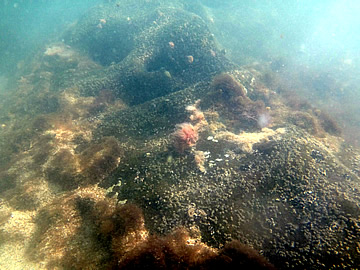

From the hotel beach I took underwater shots close to shore.
Because there is broken coral it can be quite sharp underfoot, not to mention "sea creatures" which the hotel warns about! Beach shoes are advisable.
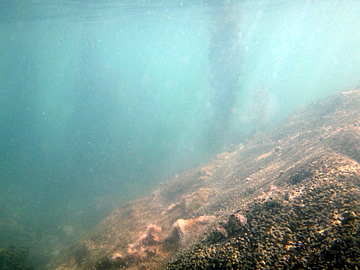
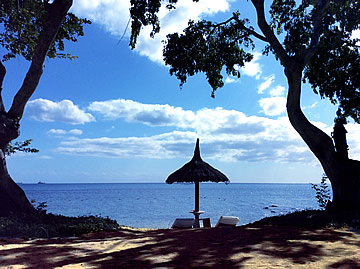
There were two or three different types of small fish here, but, again, not many of them.
Apart from the underabundance of wildlife, though, the seascape is beautiful underwater.


Port Louis is the capital of Mauritius, about 5km south of where we were staying in Balaclava.
Mauritius being such a multicultural place we thought a street food tour would be an excellent way to get to know the city. My Moris had the perfect thing: a full morning exploring the city's heritage and its local foods.





We, and one other tourist, were taken around the city by Maya, the founder of My Moris, and a trainee. Maya is lovely and really knowledgeable and we couldn't recommend this tour highly enough.1

Lying on maritime trade routes, in particular the spice trade, has meant that Mauritius has a real melting-pot of influences manifested in the different dishes, including Indian, African and Chinese as well as European. As you might expect, spices are used liberally, particularly chili.

From the seventeenth century the harbour at Port Louis was being used by the trading ships. First the Dutch then the French established colonies here, and it was occupied by the British during the Napoleonic wars until independence in 1968. The country's prosperity was built on maritime trade and its strategic position, but this altered with the opening of the Suez Canal in 1869.
We met up on the waterfront, just us and one other with our guides, and headed past the central market - which we would visit later - to a street which was very Indian in character.


Our first street food was on this "Indian street" and was a classic Mauritian snack: gateaux piments or chili cakes, made from soaked split peas, chili and herbs and spices such as coriander and cumin - absolutely delicious. Freshly made at one of the many small vendors we saw. Nowadays they operate from within any space off the street as they have recently been banned from the streets - it has lost the city much character according to Maya.

We next stopped at a long-established wholesale warehouse, Abdulla Ebrahim & Co. on Queen Street, where the price of various basic foodstuffs was marked on a huge whiteboard: sugar, flour, salt, semolina, rice, lentils, split peas, noodles - right through to Omo, Ovaltine and Weetabix!

As I understood it, these are all imported goods, many since colonial times.
We turned of Queen Street into Jummah Mosque street where the most important mosque in Mauritius is located, the Jummah Masjid Mosque. In pristine blue and white, with its cool white interiors it is a beautiful, cool oasis in an otherwise rather run-down neighbourhood.

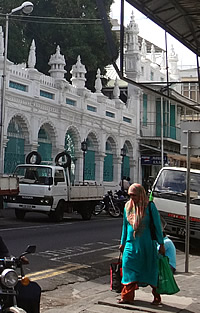
The mosque actually stand at the western extremity of Port Louis' Chinatown and we made our way up Royal Road to sample some of its culinary offerings.


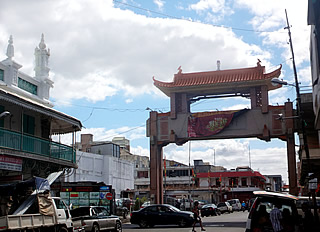
We had dim sum in a thin broth in a corridor cafe, really a remarkably narrow space in which to cook, but not the only one to exist. The dim sum were a little too glutinous for me, some of the best we've had were in New York's Chinatown and they are very hard to beat.

Next stop was an outdoor marker near the end of the harbour. It had a lot of stalls where people were cooking. We were having some kind of spicy wrap at a particular stall but the vendor was very busy so we wandered through the market first, stopping to have a refreshing drink from a fresh coconut on the way.


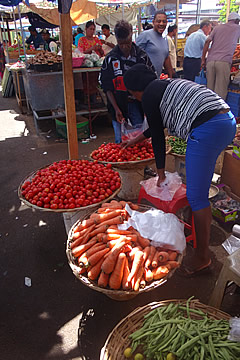





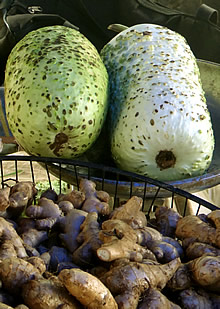




Finally we went back to the stall for our spicy wraps - dhal puris, which were freshly made and excellent. This is another very typical street food made form very simple ingredients: freshly baked flat bread stuffed with cooked yellow split peas flavoured with turmeric and cumin.
Time for something sweet - off to a tiny Chinese bakery. Maya bought a selection of sweet things, my favourite was the Moon Festival cake made with gorgeous lotus seed paste. It's only made around the time of the Moon Festival so we were lucky.

On to a rooftop pagoda with panoramic views across the city and out to sea.
The Fock Diack Pagoda is quite large and has one room dedicated to the memory of ancestors.
This was a very special visit arranged by My Moris - the pagoda is not open to the general public.







Back at ground level, we visited one of the very few remaining original houses. It must once have been quite fine and looks to be in a reasonable state.



In truth, much of the city, away from the waterfront, is very run down, some of the areas we passed through I don't think I would have been too keen to go to without a local!
Our final tasting stop was to have a cup of the local tea. It was extremely sweet and flavoured with vanilla - not something I liked at all.
Again this was in a very small, very basic cafe, the kind used by locals and rarely by tourists. My Moris make a point of taking you to places like this so that you get a feel for how the people really live and work.
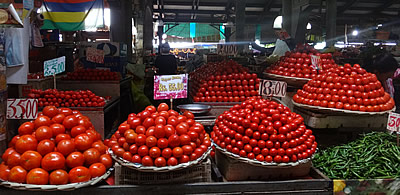
We returned to our starting point at the waterfront via the Central Market. Very colourful, as most produce markets usually are. Mostly fruit and veg, of course, but also many ingredients reflecting the multicultural nature of the island such as Chinese sauces, noodles and herbs.



After the tour we explored a little more of the city closer to the waterfront before taking our taxi back to the hotel.



Strictly the Sir Seewoosagur Ramgoolam Botanical Garden, alternatively the Pamplemousses Botanical Garden, whatever the name there is a wide variety of plants here as well as a large colonial house, lakes and giant tortoises.


Almost the first thing you come to through the entrance is a replica model of the early Mauritian sugar mills.
There is a memorial to Sir Seewoosagur Ramgoolam in the garden, his name actually crops up all over Mauritius - he was a leader in the independence movement and prime minister.
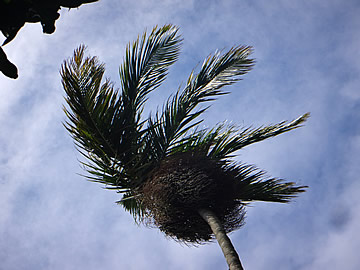




The rectangular pond of giant water lilies is one of the highlights of the gardens. Victoria Amazonica (it originates in Brazil) was dedicated to Queen Victoria by its German discoverer, Thaddeaus Haenke.


The leaves are quite remarkable, being flat with vertical rims, and can reach a diameter of three metres. The flowers bloom at night and turn from white to violet the following day.









